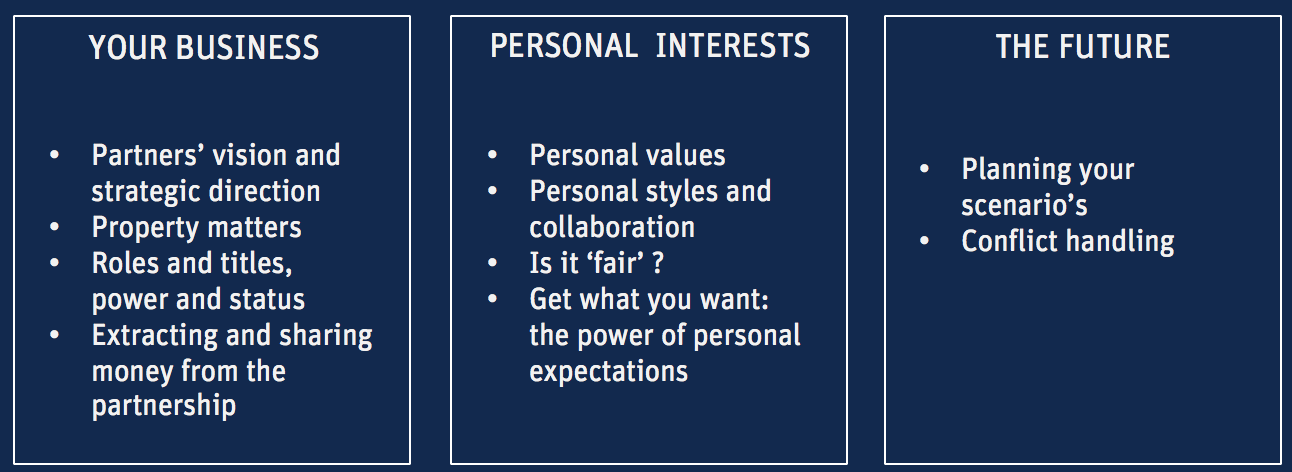Partnership Charter Part 2: What's the content of a partnership charter?
In our blog last week, we talked about the importance of a partner charter to develop and guarantee a sustainable partnership between partners. In this blog we briefly discuss what a charter should entail.

BUSINESS
1- Partners jointly decide on a mission, a vision and a strategic direction.
Partners substantially increase their chances of success if they agree on the mission, vision and outlines of a strategic plan and if they communicate this in the same way inside and outside the partnership. The strategic plan should be detailed enough to bring the partners' visions back to reality and ensure that they take the same path to their goal. It contains a business model, a number of business objectives and an implementation strategy.
2- Partners decide on ownership.
Ownership can mean something different for each partner. Partners need to understand each other's aspirations. For example, it could be the entitlement to the daily management authority, or (type of) work and remuneration, or entitlement to profit, or participation in strategic decisions. What partners get out of a partnership should not necessarily be linked to his/her personal ownership interest, i.e. shares.
3a- Partners decide what role each partner will play, what title they will receive and how they manage the organisation
In order to achieve a well-oiled operational operation, it is necessary to determine who will take on which operational role in the organisation. It is also important to determine who will perform
which management function(s). Who will become manager? Who takes financial management? A process of evaluating everyone's work should be discussed as well.
3b- Partners decide if they want a Board and what it looks like (Governance).
This is especially valid for larger organisations. Smaller organisations may consider installing an Advisory Board. At least a process of monitoring strategic direction and results need to be put in place, as well as meeting structures and decision-making rules.
4. Partners decide on remuneration.
How are working partners rewarded? Is there a minimum or maximum wage? Are there bonuses? Is profit paid out? Personal situations of partners are an important factor to take into account.
THE PERSONAL SIDE
1. Partners know and discuss each other's personal values.
A style describes how a person works, values explain why he/she behaves this way. Knowledge about this helps to work better together. Partners can also decide to choose 1 or 2 values that guide their daily actions.
2. Partners know and discuss each other's personal styles.
A better understanding of each individual personal style, and the willingness to take this into account and act differently, improves the cooperation between partners.
3. Partners evaluate their partnership annually.
Once a year a "fairness" test is done with all the partners to see if the partnership is in balance. This is based on the perception of each partner and is determined on the basis of the following questions. How satisfied am I...
1/ with my contribution today? (work, knowledge, network...)
2/ with what I receive? (money, appreciation, satisfaction...)
3/ with what I contribute compared to my partners contributions?
4/ with what I receive compared to what my partners receive ?
5/ in general with the state of affairs in the organisation?
4. Partners talk openly about what they expect from each other.
The aim is to avoid expectations that are not fulfilled and lead to frustrations.
THE FUTURE
1. Partners prepare for unexpected scenarios.
Partners discuss what steps they wish to take in case of an unexpected situation. Examples are: the company runs out of cash, a partner wants to leave (with or without selling shares), a number of key employees leave at the same time...
2. Partners define the outlines of conflict handling.
This describes which process the partners follow in case of a conflict. For example:
1/ step 1: we talk to each other.
2/ if not, step 2: we ask a known person to mediate.
3/ If not, step 3: we ask a professional mediator...

